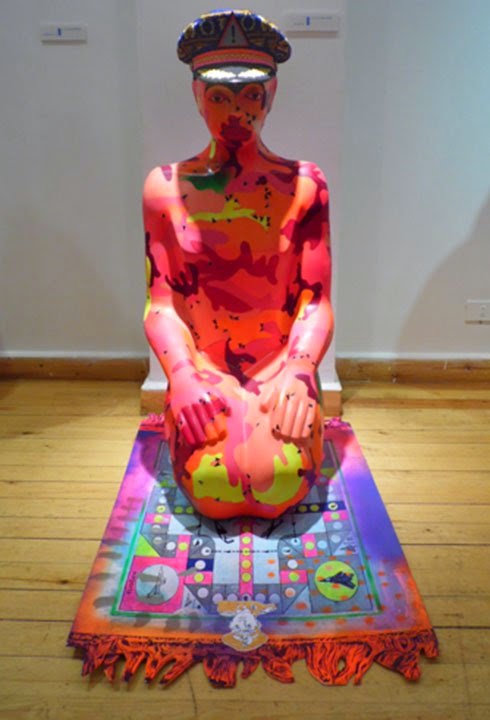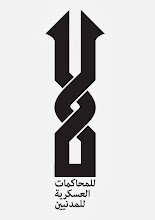Sada
Photo Essay: Worshiping the Egyptian State
September 9, 2014Angela Boskovitch
Abo Bakr was an assistant professor of fine arts before the events of January 2011, when he turned the city walls into his canvas and the street into a kind of open-air classroom.
“When you fight with the regime, you fight with yourself and your profession too, because art institutions are really lacking here,” he said.
It’s not uncommon for public museums to be closed for years in Egypt with no planned reopening. The famed Mohamed Mahmoud Khalil Museum has been closed since 2010, when a prized Van Gogh painting was stolen. Twenty-five other museums were subsequently closed due to security concerns raised by the theft, and though some have since reopened, they conduct little public educational outreach and are largely not visited by locals.
Artists and independent cultural actors have stepped in to fill the void with street art projects and independent cultural spaces.
Prior to his participation in Amen, a CARAVAN group exhibition, Abo Bakr’s work has been featured in several other exhibitions and murals since the events of 2011. Egyptian artwork over this period, documented in countless photographs shared by social media users, has created a kind of visual memory of the revolution.
Murals and graffiti have recorded events as they happened; for example, a mural on Mohamed Mahmoud Street done in February 2012 displayed the portraits of those killed in the Port Said football massacre.
And in November 2013, the revolutionaries and artists painted a pink camouflage mural as a commentary about authoritarian leaders who act with impunity, disputing the official narrative that conflated all protesters with supporters of Mohamed Morsi, the deposed Muslim Brotherhood president.
For this sculpture, Abo Bakr took the pink camouflage motif he and others painted last year as his starting point. The figure kneels on a prayer mat designed to resemble a popular board game with the image of an anonymous general at the helm.
“Religion is part of the game of power here in Egypt,” the artist said.
Referring to his sculpture, he adds “I didn’t paint something beautiful, but something that people should see now. This figure represents anyone who worships strongmen.” Abo Bakr’s praying figure prompts viewers to reexamine President Abdel Fattah el-Sisi’s statements and question how religious arguments are used by political figures to gain popular support.
During media and campaign appearances, Sisi has leveraged the Islamist dialogue with frequent references to God and morality. In his first ever TV interview broadcast on May 5, then-candidate Sisi said he was “an Egyptian Muslim who loves his country, religion, and people” and reminisced about growing up in an old Cairo quarter where Jews, Christians, and Muslims lived together.
The former military head billed himself as the defender of “moderate Islam,” implying that religious discourse of groups such as the Muslim Brotherhood had “robbed Islam of its humanity.”
Before that pre-recorded interview aired, Sisi met with members of the media in a forum on May 3 where he talked of his unwavering faith, saying that God wouldn’t abandon Egyptians after all they’d gone through, and that as president he’d only be accountable to God and the Egyptian people.
Abo Bakr’s CARAVAN sculpture also wears a military-style hat. At the center of it is a triangular sign with an exclamation mark that one encounters on the road warning of dangers ahead—this is intended to jolt the audience. “The idea is to wake people up and link events happening around them,” Abo Bakr explained.
The statue is also peppered with finely drawn small flies representing corruption, a reference to the military-owned companies that operate in nearly every sector without effective oversight or transparency.
Despite the country experiencing daily power cuts, $10 billion in gas revenues had been lost between 2005 and 2011 in corrupt contracts that under-priced exports, and citizens are still paying the price for elite networks of corruption.
Also in keeping with his cartoonist-like commentary, Abo Bakr stenciled the flag of Saudi Arabia as a kind of brand label on his sculpture’s back—referencing the growing influence of the kingdom on the Egyptian state. Saudi-Egyptian joint ventures carry out mega development projects throughout the country, often on state-owned land, and the kingdom has granted Egypt more than $12 billion in much-needed aid after the overthrow of President Mohamed Morsi.
King Abdullah’s first visit to Egypt since Mubarak’s ouster came on June 20, 2014—a way to congratulate the former defense minister who once served as military attaché in Riyadh on winning the presidency. When Sisi then visited Saudi Arabia on August 10, he was awarded the King Abdulaziz Necklace, the country’s highest and most prestigious medal.
The inclusion of the symbolically painted sculpture in the CARAVAN exhibition is a testament to the work of a new generation of Egyptian artists. “The country’s younger artists are using an international code of language,” explained Josef Danner, who included the artwork of young Egyptian artists in his 2013 poster project that covered billboards around Austria.
“They pick up ready-made images that are part of the collective identity and then rework and combine them surrealistically using new technologies in a way that really shocks the older generation of artists.”
Many younger artists like Abo Bakr say they’ve chosen to leave the constraining hierarchy of art academies and institutions in order to contribute critical media at a pivotal time in history. Ironically, this artwork has now made it back into the more traditional art space.
*Photos by Angela Boskovitch & Amanda Mustard


















No comments:
Post a Comment